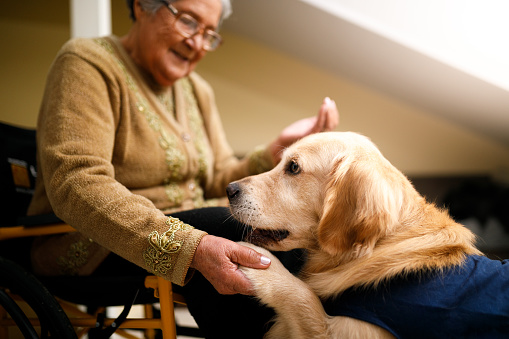Animal assisted therapy is a therapeutic program supervised by a professional that aims to provide care to a patient through the presence of a pet: dog, cat, Exotic Pet and many others. These innovative methods considerably improve the health of people suffering from psychological or sensory disorders, physical pain, social difficulties…
Not to be confused with animal assisted activities (AAA) which consist in boosting people, educating children or entertaining them. These are introduced in schools, prisons or possibly in a therapeutic context, but they do not require a particular qualification, unlike pet therapy. In France, EHPADs are already testing and approving zootherapy which brings happiness to their residents.

The fundamental principles of pet therapy
Beware, the cure of an illness is not promised. That said, pet therapy does guarantee considerable improvements in the face of a given problem. It is based on the human-animal relationship and by reinforcing their exchanges, it improves the mental, physical and psychological health of the person in need. These are some of the remarkable benefits of pet therapy that really help patients gain confidence, rebuild their lives, move forward or age well as serenely as possible.
- optimism: helps to see life on the bright side;
- correcting behaviors: certain attitudes aim at changing or evolving in a positive way;
- digesting an emotional shock : helps to overcome difficult moments in life (death, acceptance of an illness, accident, separation…);
- relax: a real anti-stress, it often teaches to relax and reduce anxiety;
- lowering blood pressure: linked to a stressful situation, it helps to reduce hypertension;
- to revalue one’s self-esteem: with it, one feels useful and recognizes one’s qualities (and one’s defects, one accepts them);
- to fill a gap: the absence of a loved one or an emotional need can be effectively compensated thanks to pet therapy;
- to open up to others : favors communication with the outside world and fights against isolation or withdrawal;
- Connecting with nature: rediscovers an essential link with the natural environment;
- to accept and love oneself: to let go of the gaze of others and to know how to appreciate oneself without the approval of one’s entourage.
Animals used for zootherapy
A source of well-being, zootherapy “uses” several familiar animals as part of an animal-assisted therapy.
The horse
Known for easily reconciling its host to nature, the empathy of the horse is a source of appeasement for those who suffer: elderly people, children or adults of all ages, their health improves and their strong emotions are relieved. This therapy is called equitherapy and the health professional who supervises it must be a certified equestrian.
The dog
This canine conciliator knows how to work easily with people with disabilities. It is more common in AAA (Animal Assisted Activities), but it is also present in zootherapy for those who are looking for physical and mental well-being. It is not by chance that the dog is said to be man’s best friend.
The cat
The feline has remarkable virtues: the company of a cat brings many health benefits. It improves heart problems, lowers blood pressure, reduces stress, transmits positive waves, prevents epileptic seizures and promotes sleep. For group or individual sessions, the presence of a cat immediately soothes the patient and gradually stimulates him/her.
The dolphin
This is dolphin therapy: the sensory exchanges between the person and the dolphin can resolve many major difficulties or health problems (autism, phobias, Down’s syndrome, depression, deafness, anorexia, cancer). The therapeutic sessions take place at sea or in the pond, in the animal’s natural or artificial aquatic environment.
Exotic Pets
Small rodents such as rabbits, gerbils, hamsters, or ferrets are predisposed to help humans develop some of their cognitive abilities. Elderly people who have difficulty expressing their emotions use small animals, with surprising results, especially in the area of disability.
The health benefits of pet therapy
The participation of an animal in a group will install a great comfort in its social interactions. Verbal exchanges voluntarily increase, barriers fall and the benefits begin right away. Being in contact with an animal relieves stress and promotes letting go. Their soothing and comforting effects improve the patient’s physical and mental health.
Several scientific studies have shown that raising a pet is good for your health in every way. Moods are lifted, pressure is relieved, family ties are strengthened, and the ability to concentrate increases. To break the solitude, being in the company of an animal is ideal to feel less lonely, and to exchange with the outside world.
The life of schizophrenics is clearly improved and their socialization is restored. Hospitalized people become less nervous and regain the hope of living thanks to regular visits from their animals. Alzheimer patients are less agitated in the presence of an animal. Their state of health deteriorates less quickly, because they maintain a constant weight. Finally, sick or hospitalized children are happy in the presence of an animal, forget their pathologies, sometimes painful, and preserve some of their innocence.
In any case, the animal will be forced and compelled to participate in the care of the patient and to interact. It goes without saying that the therapeutic practice is carried out in a safe and respectful manner with an animal. Moreover, to obtain beneficial effects on the human being, his or her full cooperation and development are necessary. The animal assisted therapy must be well trained and have a thorough knowledge of the animal in question.






